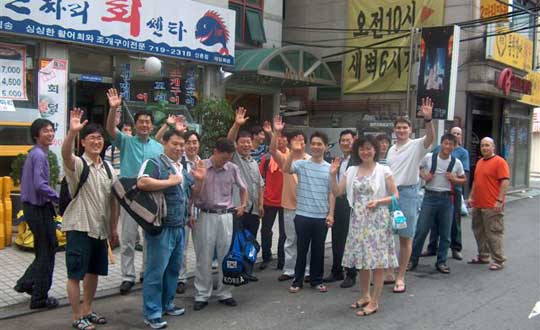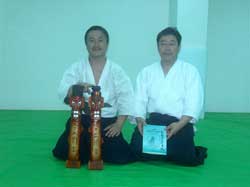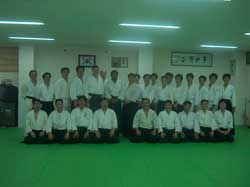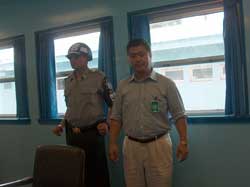A visit to Korea.
by Gaku Homma
Nippon Kan Kancho
You can always spot someone who has practiced Aikido for a long time from a distance; it is in their walk. We call it hakamaaruki (hakama walk) in Japanese and it describes the gate of someone who has worn a hakama for a long time. It can be a badge of honor, and I have seen younger students walking behind senior sempai or instructors trying to imitate this walk. Another tell-tale give away of someone who has practiced Aikido for a long time is if they do a nikkyo or kotegaeshistretch on themselves when they are nervous.
It is natural for students to imitate the movements of their instructors, and I have seen students that even take on the same mannerisms and speaking patterns of their instructors. Students that do this naturally show the sincerity and desire to learn in their practice. High on a hill in Seoul, Korea, stands the Shilla hotel. I waited in the lobby of the Shilla hotel as Yoon Sensei, his wife and students arrived to pick me up. The Shilla hotel lobby is quite large, but I recognized Yoon Sensei and his group immediately as they entered the lobby. Yoon Sensei walked exactly the same way Kobayashi Shihan walks. This made me smile.
Yasuo Kobayashi Shihan, Yoon Sensei’s instructor is Founder of Aikido Kobayashi dojo in Kodaira City, Tokyo, Japan. www.kobayashi-dojo.com Kobayashi Shihan is a very active instructor world-wide and is a shihan I have great respect for. He has organized a large network of shidoin(instructors) in the Americas, Europe and Asia.
Ik-Am Yoon Sensei is the Dojo Cho of Korea Aikido Federation’s Hombu dojo in Seoul (5F.31-8 Nogosan-Dong, Mapo-gu, Seoul 121-100 Korea). Yoon Sensei is the first Aikikai pioneer instructor in Korea, and has built a new following of Aikido that will carry well into the future. I will explain in more detail how Yoon Sensei happened to meet Kobayashi Shihan, but first I need to tell you about an experience I had in the first days of my visit to Seoul.Traveling in Korea on a tour bus, there was an American man sitting next to me. I was to find out that he was the leader of a well known world-wide religious organization that was founded in Korea. This man was the supervising escort for about twenty American followers of this particular religion who were on the bus as well. The bus was also carrying a group of Japanese tourists as it headed north for a tour of the Demilitarized Zone between North and South Korea.
The group of Americans had not arrived for departure on time, and the tour bus was twenty minutes late in departing the hotel in Seoul. As the bus waited to move forward, a young Korean woman who was serving as a guide for the trip began her introductions. The woman spoke Korean, English, and Japanese. The guide first apologized in Japanese for the late departure of the bus, as the American passengers clambered slowly to their seats. Finally the bus departed and the guide continued her tour monologue in Japanese. The American leader beside me was not happy about this. “English is the international language”, he said to himself so that others could hear. Soon the guide began speaking in English. She said, “Attention everyone, this is a group activity, so please be courteous to others by being mindful of the time. Please try to return to the bus during scheduled stops as scheduled. Especially at the DMZ, security is very tightly controlled and time limits are strictly enforced. Thank you for your consideration.” The American leader sitting next to me seemed offended by her remarks, and turned to me. “What is she talking about? Is she Japanese or something?” “Why,” I asked. “Only the Japanese would talk so rudely” he answered heatedly.
We had a three hour bus ride ahead of us to reach the DMZ, and for the entire three hours I was subjected to a continued litany of derogatory remarks from the American leader about the tour guide. Finally he reached for his cell phone and I heard him saying “She is not to be hired again.” The young woman tour guide he was referring to was a college student who was majoring in English. This was a part-time summer job for her. English was obviously her second language and I thought she was doing a good job. I thought her gentle reminder for everyone to be on time was appropriate. It was shocking to me that the American “leader” sitting next to me was not more sensitive or wiser.
I had been holding my tongue up to this point and had tried to remain a gentleman, but finally found the situation becoming intolerable. “Why do you correlate some one you consider rude with being Japanese?” I asked. “I have known thousands of Americans, but I think you just might be the rudest American I have ever met.” I said as I looked directly into his eyes. He said nothing in return…
After we returned from the DMZ, one of the activities of the world peace convention I was attending was a large banquet. All of the tables were set with place cards that had been carefully arranged by the organizers. As everyone found their places, we were instructed to exchange name cards with our neighbors in a kind of a ceremony. Next to me sat a middle aged Korean woman. As we were instructed to exchange name cards, she turned to me and looked me up and down from head to toe a couple of times. Finally she turned to the woman she had arrived with and said, “He looks Japanese, I don’t like the Japanese.” Before she had decided I was Japanese she had been quite friendly. I think she thought I was American because I had come from the United States. Once she determined I was Japanese she refused to speak to me. There was no point in me staying at this table, so I left the banquet hall…
These two experiences back to back, shocked me. I had no bad thoughts of Korea or Korean people and yet I had had two experiences where people in Korea were not happy with my country of Japan. When I was a child, one of my best friends in elementary school was from Korea, and now as I live in the United States I visit Korean markets and restaurants frequently. My personal massage therapist is Korean. In all of the Korean establishments I frequent in the United States, the owners and employees are always friendly and kind. Even with language barriers I have developed good relationships with many of my Korean friends in Denver. This first trip of mine to Korea had reminded me of my childhood, and I was enjoying the experience. These two instances were unsettling however, and reminded me that there had indeed been bad times between Japan and Korea in our history, and as I was discovering, repercussions of this history could still be felt.
Between 1910 and 1945, Japan forcefully invaded and occupied the Korean Peninsula. During this occupation of Korea, the Japanese military leaders forced the Korean people to change their language, customs, religion, even their names under penalty of death. Some Korean people were inducted by force into the Japanese army. Others were forced to work in the mines and the fields as slave laborers. Young Korean women were abducted and used as concubine for Japanese soldiers. The conduct of the Japanese military and their leaders at this time in history left much to be desired in my opinion, and it was only sixty years ago. For their part in this sad time in Japanese history, the Japanese government has now officially apologized which is a start to a healing process that may take generations to come to fruition.
After the war ended on August 15th, 1945, all of the Korean people on the Korean peninsula were freed from the reign of oppression they had been living under. Since that time, Korea has gone through a period of rebuilding their national pride and revitalizing their national culture. Even as recently as five years ago, as an understandable reaction to the reign of terror they had been subjected to, Japanese music, movies, language and other Japanese influences were officially banned in Korea. Japanese words that had been commonly used in Korea were changed to adhere to Korea’s new sense of identity. Some Japanese words used in Korea, written in the same Japanese characters are now used and pronounced differently. Even the word Aikido, written with the same characters is pronounced Hapkido in Korea. The word Judo is pronounced Yudo, and Kendo is pronounced Kamudo.
Only a couple of years ago, there was a Korean singer who was wildly popular in Japan for the Japanese songs she sang. Upon her return to her native country of Korea, although popular with fans, she was officially banned because the songs she sang were Japanese. This banning of Japanese influence over contemporary entertainment is a remnant left over from the government’s attitudes in the post war, post occupation era in Korea that has continued now into the 21st century.
I though again of the American leader of the Korean based religion I had sat next to on the tour bus that had associated rude behavior with the Japanese nationality. I thought of the Korean woman at the banquet who refused to exchange name cards with me because I was Japanese. Both of these attitudes I realized were also left over repercussions of the time of the Japanese occupation of Korea. Even though those days are now just part of history, the effects can still be felt, and must be endured today by people like the young Korean tour guide on the bus.
As a Japanese man born after WWII, I personally do not have any direct experiences of those times in our history. It is painful for me to see the repercussions from those days being played out today. I cannot run away from the understanding of the possible reasons for this behavior if I am to think about the future for both Korea and Japan. I think it is important for me to try to understand the negative influences Japan had in many places during that period in history to be capable of pursuing a future of peace for both countries. I do this out of my respect for the Korean people of today.
Why? One reason is the people I met in Korea on this visit, and the kindness and generosity that was so much part of their spirit. On this trip I had the opportunity to meet Yoon Sensei, his wife and his students who completely dispelled the bad feelings I had had after my experience on the tour bus and at the banquet. Yoon Sensei and his wife were so warm and friendly, I felt as if I had known them for years instead of hours. Yoon Sensei’s wife spoke fluent Japanese so I was able to communicate well with all of them. They gave me a chance to teach, and the practice together with Yoon Sensei’s students was a wonderful experience. His students were young, healthy, active, very friendly yet very serious about their study and their practice. I see in them that the future of Aikido in Korea will be healthy and strong.
Yoon Sensei was born in 1960, and has been a major influence in Korea as an Aikido pioneer. As a child, Yoon Sensei’s father instructed the police departments in the art of Taekwondo, so he was exposed to and became interested in the martial arts at a very young age. As a boy, he practiced Taekwondo, Kendo, Hapkido, Karate and kick boxing.
During his time in the military, Yoon Sensei was a Taekwondo instructor for other servicemen. After his service, he became the first kick boxing promoter in Korea. It was on a
trip to Taiwan to attend a kickboxing tournament that he was first introduced to Aikido. He noticed a sign written in Japanese which he knew as the Korean word for the Korean art of Hapkido. As it turned out, it was the characters for the Japanese art of Aikido. This was the beginning of a long relationship between Yoon Sensei and Kobayashi Shihan whom he met that day in Taiwan. It was not long before he became an uchideshi student to Kobayashi Shihan at his Kobayashi dojo in Japan. Since his days of intense training with Kobayashi Shihan, Yoon Sensei returned to Korea to become a pioneer in teaching the Japanese art of Aikido there. Since his return to Korea, he has returned many times to Japan to visit his teacher Kobayashi Shihan, and their relationship continues to this day.
When Yoon Sensei first met Kobayashi Sensei he was surprised. He wrote in his autobiography, “He looks like such a kindly old gentleman, and yet he is an Aikido 6th dan. He threw me around as if it were child’s play. His techniques were completely different than the Hapkido techniques I had known. I was fascinated by his art of Aikido that was written with the same characters as Hapkido and yet was so different. I really wanted to train in this art.” In 1994, Yoon Sensei opened his first Aikido dojo in Seoul. Today, Yoon Sensei has branch dojos all over Korea.
After the end of WWII, the martial art of Hapkido was practiced in Korea. It was a bit confusing at first when Yoon Sensei returned from Japan and Kobayashi Shihan’s dojo to introduce a “new” martial art “Aikido” which was spelled exactly the same as the existing martial art in Korea, especially since the arts are so different.
Thirty years ago in the United States, Hapkido dojos could be found most everywhere. These Hapkido dojos in the United States often even had a picture of the Founder of Aikido, Morihei Ueshiba and the Japanese kanji calligraphy for Aikido hanging in their dojos. As a young man from Japan at that time, this confused me. What was being taught in Hapkido dojos was not Aikido, and yet seemed to have some ties to the Founder Ueshiba. Today, most Hapkido dojos have disappeared, and the ones that remain in the United States do not bear a photo of the Founder or the calligraphy for Aikido. What is taught today in Hapkido dojos is taught as an original Korean martial art.The history of and relationship between Aikido and Hapkido is not the main focus of this particular article. What is important to note is that there was a direct influence on the development of Aikido and Hapkido after WWII by the prevailing mood of exclusionism after the end of the Japanese Occupation. I was invited to practice at Yoon Sensei’s headquarter dojo with a selected group of his most active instructors and students from all over Korea. I was quite impressed with the powerful energy of the group. There was a strong team spirit in Yoon Sensei’s students that was infective and exciting to be around. After practice there was a welcome party where we all shared together in food, a Korean liquor called Makori and much conversation! The following day, Yoon Sensei and his top students took me sightseeing around Seoul where I was able to see and experience many parts of Korean culture first hand.
On that first fateful tour bus ride, our destination had been the demilitarized zone and the Hammonjon, the facility where meetings take place between North and South, a
building secured by military guards from BOTH sides. In 1953 a cease fire was declared between the North and the South, the country of Korea has remained divided ever since.
As I visited the facility I could not help but think what part Japan’s occupation of Korea had to play in the resulting split between the North and the South. I walked towards the entrance with the young Korean woman who had served as our guide on the bus. Even though these thoughts were in my heart, she never spoke of the past history between Japan and Korea and the sadness and tragedy that had resulted in the occupation. She spoke only of the sadness of the current separation between North and South in her country and of her hopes for the positive projects the two sides are working on together. She only spoke of the positive and for her hopes for the future and I deeply respected her for this.
- At the Hammonjon. Homma Kancho on the North Korea side.
- A view of the Hammonjon from the South Korea side.
Yoon Sensei’s Aikido Federation is growing fast, and the new generations of young Korean Aikidoka will serve as an important bridge of understanding between Japan and Korea, and Korea and the rest of the world.
I thank Yoon Sensei, his wife and his students for their gracious hospitality and also Kobayashi Shihan who not only graciously granted me permission to visit Yoon Sensei during my visit to Korea, but sent word ahead on my behalf. Kobayashi Shihan also sent me a copy of his autobiography on his fifty years in Aikido. I read his book and was impressed with the effort and diligence Kobayashi Shihan has put into building his worldwide organization. Behind his success is wisdom, wisdom evident in his granting me the opportunity to share in an experience with his organization in Korea.
I very much appreciate the opportunity.






